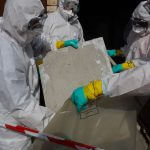
We have to start by saying that Geiger-Mueller tubes or detectors comprise two collecting electrodes: cathode and anode. You probably know that cathode is negatively charged, while the anode is positively charged.
Remember that the outer chamber wall is cathode in this particular detector, and the difference between these two collecting electrodes is between 800 and 1200 volts. The best way to understand everything about GM tube is by clicking here.
When it comes to designs, you should know that we could differentiate three basic ones including side window, which is also known as cylindrical, end window and pancake.
Let us start from the beginning.
1.Side Window GM Tube
In this particular design, you will notice a cylinder that comes from stainless steel, which serves as a cathode, while a tungsten wire is an anode, and it runs along the central axis. Remember that the main application of side window GM tube is for measuring gamma exposure.
You should know that walls are thin enough so that you can measure and count high-energy betas, which is highly important for industrial purposes. The density of thickness is the best way to describe and talk about thin materials because it depends on product thickness and density.
Therefore, the side window GM tube can easily describe the aerial density of thin materials with ease.
2.The Pancake GM Tube
On the other hand, this particular design of a GM tube features the shape of a pillbox and it includes a truncated cylinder. Similarly, as with End Window tubes, you will get one window, which comes from thin material, in most cases mica window.
You do not have to worry, because the overall thickness of the window is between 1.5 and 2 mg/cm2. At the same time, the shape of the anode is inconvenient because it features a circular configuration, which is parallel to the entrance window.
The main function of this particular design is the measurement and detection of beta-emitting surface contamination, but it responds to gamma rays and alpha particles. Before finding Geiger-Mueller Tubes manufacturer, you should learn more about the third design which is commonly used.
3.End Window GM
Similar to the side-window GM tube, the cathode of this particular design features a stainless steel cylinder. Apart from that, the anode is at one end and it can extend along the tube axis, which is highly convenient for detecting.
The tip of anode features small glass bead covering, and the window comes from mica, which means that it features small density thickness.
Remember that every single GM detector features the ability to detect gamma rays, but you can use this particular one so that you can find and count beta activity as well as alpha particles.
Fill Gas

The GM detectors feature pressurized gas inside which is a few tenths of an atmosphere, and as soon as we decide to reduce the pressure below the atmospheric, the strength of the electric field will reach the region and provide the proper voltage along the way.
The low pressure is essential because it will increase the drift velocity of positive ions that have to reach the cathode, and as a result, you will reduce overall dead time.
The gas detector features two essential components including:
- The Fill Gas – In most cases, we use neon, but you can implement others as well such as krypton, argon, helium, and others.
- The Quench Gas – We can differentiate two types of quench gas, organic quench gases and halogen quench gases. Chlorine is one of the most common halogen solutions, while you can also use bromine along the way. Even though you can find that alcohol is one of the primary examples of organic quench gas, it is much better to use isobutene. Remember that halogen-quenching agent is important for filling the gas such as krypton, argon or neon, while helium-filled tubes are perfect for employing an organic quench gas.
We recommend you to visit this website: https://www.radiationanswers.org/radiation-introduction/detecting-measuring/geiger-mueller.html so that you can read everything about GM meter and detector.
Pulse Generation
As soon as alpha or beta particles go through the detector window, they will ionize the fill gas directly by interacting with the metal wall, which will create a photoelectric effect.
The electron will ionize the gas inside the tube, and x-rays and gamma rays can also interact with fill gas instead of the wall, but that is not common and it happens only for low-energy photons.
As electrons move through the anode, they will lose potential energy and gain kinetic energy, and if the electric field features sufficient strength, they will create secondary ion pairs.
These electrons will continue to gain energy as they move forward, and that will increase the ionization in general. As a result, you will reach the avalanche of ion pairs or cascades.































